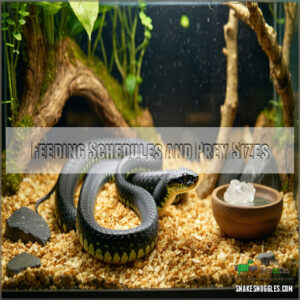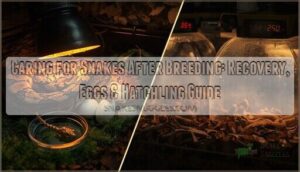This site is supported by our readers. We may earn a commission, at no cost to you, if you purchase through links.
 Snake species care tips start with choosing a low-maintenance starter like a corn snake or ball python—they’re as beginner-friendly as they come.
Snake species care tips start with choosing a low-maintenance starter like a corn snake or ball python—they’re as beginner-friendly as they come.
Set up a cozy habitat with a secure, escape-proof terrarium that matches your snake’s size, and don’t skimp on heating and hiding spots—they love their privacy.
Feed them appropriately sized prey (no larger than 1.5x their body width), and maintain a regular feeding schedule.
Handle them gently and infrequently at first to build trust—think of it as gaining VIP access to their world, and remember, consistent care will keep your slithery friend thriving.
Ready for a deeper dive?
Table Of Contents
- Key Takeaways
- Choosing Snake Species
- Setting Up Habitat
- Feeding and Nutrition
- Maintaining Health
- Ongoing Care Tips
- Frequently Asked Questions (FAQs)
- How do I care for a snake?
- Should you care for snakes as pets?
- How do you handle a pet snake?
- How do you care for a king snake?
- How do I choose a snake species?
- How to prepare a snake’s home?
- How to care for snakes for beginners?
- What is the easiest snake to maintain?
- How do you keep snakes healthy?
- Do snakes recognize their owners?
- Conclusion
Key Takeaways
- Choose beginner-friendly snake species like corn snakes or ball pythons for easy care and gentle temperaments.
- Set up a secure enclosure with proper heating, humidity, and hiding spots to match your snake’s natural habitat.
- Feed appropriately sized frozen-thawed prey on a regular schedule, keeping meals no larger than 1.5x your snake’s body width.
- Handle your snake gently and infrequently at first to build trust and reduce stress.
Choosing Snake Species
Choosing the right snake species is one of the most important steps in getting started as a responsible owner.
You’ll want to focus on beginner-friendly species with manageable size, gentle temperaments, and straightforward care needs.
Beginner-Friendly Species
Beginner-friendly snake species make excellent pets, offering low-maintenance care and gentle temperaments.
Start with these beginner snakes:
- Corn snakes: Hardy, easy-going, and ideal for first-time owners.
- Ball pythons: Known for their docile nature and simple ball python care needs.
- Garter snakes: Active and engaging, great for learning handling tips.
- Rosy boas: Small size, minimal pet costs, and easy pet snake care.
When selecting a pet snake, consider researching snake care tips to guarantee a happy and healthy pet.
Factors to Consider When Selecting
Choosing the right snake species is like finding a dance partner—you want compatibility. Research snake temperament, adult size, and habitat needs before jumping in.
Beginner-friendly snake species like corn snakes or ball pythons make it easier. Think about your experience level and the time you can dedicate to care.
Remember, habitat size and pet costs shouldn’t surprise you later!
Cost Considerations for Different Species
Moving from selecting the right snake, let’s talk money. Snake care costs can vary widely, so balance your budget planning with your preferences.
- Initial Costs: Expect setup costs of $200-$400 for habitat and essentials.
- Snake Pricing: Common options like corn snakes start at $30, exotic morphs hit $500+.
- Monthly Expenses: Weekly feeding costs and supplies run $20-$50.
Setting Up Habitat
Creating the perfect habitat for your snake isn’t hard, but it does take some careful planning.
You’ll need to balance size, temperature, and humidity to match your snake’s natural environment.
Terrarium Selection and Size
Your snake’s enclosure is its home, so pick wisely!
Glass terrariums, PVC enclosures, or sturdy wooden vivariums all work well, depending on your habitat design.
Tank size matters—a 20-30 gallon setup suits small species, but always match terrarium size to your snake’s growth.
Verify that the ventilation system prevents stuffiness while maintaining safety.
Choose durable, escape-proof materials!
When selecting a terrarium, consider the importance of proper glass terrariums to create a suitable environment with proper ventilation.
Substrate and Ventilation Options
For a happy, healthy snake, picking the right substrate types is key. Aspen shavings or coconut fiber work wonders for comfort and humidity control.
Combine this with proper ventilation systems to guarantee ideal airflow management. Balanced temperature gradients prevent stress, so your enclosure stays cozy.
Remember, poor ventilation leads to stagnant air—a snake’s least favorite thing! Researching snake substrate options is vital for creating a suitable environment, considering the best snake care products.
Lighting and Heating Requirements
Your snake’s lighting needs revolve around heat lamps, UVB lighting, and heat mats to guarantee proper temperature control.
Create thermal gradients with basking spots around 85-95°F and cooler areas at 75-80°F.
Use a heat lamp for day warmth and heat mats for consistent night heat.
Snakes thrive with balanced temperature gradients that resemble their natural habitat.
Feeding and Nutrition
Feeding your snake the right diet is key to its health and happiness, so you’ll need to stick to species-specific needs.
From balancing prey size to timing meals just right, a little preparation goes a long way in ensuring your scaly friend thrives.
Dietary Needs for Different Species
As you prepare your snake’s habitat, it’s good to understand their dietary needs. Each snake species has unique nutrition requirements. Some snakes thrive on rodents, while others enjoy birds or fish.
Here’s how to meet their needs:
- Match prey items with the snake’s natural diet.
- Rotate prey for balanced species nutrition.
- Use dietary supplements sparingly for young snakes.
Creating a suitable environment also involves considering the natural habitat needs to guarantee the snake’s overall well-being.
Feeding Schedules and Prey Sizes
Stick to a snake feeding guide to keep things simple—young snakes eat every 7-10 days, while adults stretch to 10-14 days.
Prey size matters; it should be about 1.5 times the snake’s widest body part for safe swallowing.
Feeding times depend on the snake’s activity, so aim for evenings. Frozen prey offers variety and convenience.
Understanding the snake feeding schedule is essential for the health and growth of your pet snake.
Supplementing Meals With Calcium
While following your snake’s feeding schedule, consider its calcium needs.
Most snakes meet their nutritional requirements through whole prey, but occasional dietary supplements like calcium powder can fill small gaps.
If using supplements, choose one with vitamin D3 for better absorption.
Over-supplementing isn’t helpful and might harm.
Prioritize balanced snake nutrition for strong bones and healthy growth—no need to overthink reptile nutrition!
Maintaining Health
Keeping your snake healthy means watching for signs of illness and staying consistent with routine care.
Regular vet visits, clean habitats, and quarantining new snakes can prevent most problems before they start.
Monitoring for Signs of Illness
Spotting early signs of illness is key to snake health.
Watch for these issues:
- Respiratory infections: Open-mouth breathing or wheezing.
- Shedding problems: Retained skin around the eyes or tail.
- Abnormal weight loss: Gradual or sudden.
- Skin lesions or parasites: Unusual spots or movement on the body.
Quick action prevents minor concerns from becoming major.
Regular Veterinary Check-Ups
Don’t skip those yearly veterinary checkups! Regular vet visits are essential for snake health, catching diseases early, and preventing infections.
A checkup includes weight, skin, and mouth inspections. Build a relationship with an exotic pet vet for confident care.
Preventative measures save headaches—and your snake’s life!
| Vet Visit Tips | Check-Up Schedules | Preventative Care |
|---|---|---|
| Monitor weight | Annual exam | Spot infections |
| Inspect shedding | Skin evaluations | Prevent diseases |
| Check breathing | Mouth assessments | Maintain environment |
Quarantine Procedures for New Snakes
When bringing home a new snake, a 60-day quarantine is essential for snake health and disease prevention. Isolation tips include using quarantine tanks with proper ventilation systems to create a stress-free environment.
Snake acclimation takes time—watch for signs of illness. Keep them separate from other pets.
Implementing proper disease prevention measures is essential for the health of your snakes.
- Use a separate enclosure.
- Monitor shedding and appetite.
- Disinfect tools regularly.
- Inspect stool for parasites to ensure the overall health of your snakes and maintain a stress-free environment.
Ongoing Care Tips
Caring for your snake doesn’t stop at feeding or setting up its enclosure—it’s an ongoing commitment to their health and well-being.
By mastering proper handling, regular cleaning, and maintenance routines, you’ll help your snake thrive for years to come.
Handling and Support Techniques
When handling your snake, create a stress-free environment by using gentle handling techniques. Always support its body, avoiding the head and tail. Snake hooks offer safety during initial interactions. Pay attention to behavior cues for trust-building.
Understanding proper snake handling techniques is vital for a safe experience. Here’s a quick guide:
| Technique | Purpose |
|---|---|
| Wash hands | Prevents germs |
| Use snake hooks | Promotes safe handling |
| Support mid-body | Reduces stress |
| Avoid head restraint | Builds trust |
| Stay calm | Promotes positive behavior |
Cleaning and Maintenance Schedules
A clean snake enclosure keeps your pet healthy and happy.
Stick to weekly terrarium cleaning with these steps:
- Replace substrate to prevent mold.
- Sanitize water bowls and hides.
- Check humidity control and adjust settings.
- Inspect for waste and old food.
- Reset the setup to minimize stress signals.
Routine maintenance supports your snake’s wellbeing and guarantees a safe enclosure setup, which is essential for your pet’s wellbeing.
Additional Facts and Considerations for Owners
Owning a snake means understanding their quirks and acting responsibly. Secure enclosures prevent crafty escapes. Watch for changes in snake behavior—it’s their way of communicating.
Consider pet insurance for longevity factors like unexpected health issues.
Here’s a quick reference:
| Factor | Tip |
|---|---|
| Escape Prevention | Use lockable, sealed enclosures. |
| Snake Health | Schedule annual vet checks. |
| Responsible Ownership | Provide proper care daily. |
| Snake Welfare | Monitor temperature and humidity. |
Always prioritize their well-being!
Frequently Asked Questions (FAQs)
How do I care for a snake?
Did you know snakes can live over 20 years?
Keep their enclosure warm (85°F basking, 75°F cool), clean, and secure.
Feed pre-killed rodents, maintain humidity, and handle gently for a happy, healthy snake!
Should you care for snakes as pets?
Caring for snakes as pets can be rewarding if you’re ready for the commitment.
They’re low-maintenance, fascinating creatures, but you’ll need proper knowledge of species, habits, and safety to guarantee both your and the snake’s well-being.
How do you handle a pet snake?
Approach your pet snake calmly, supporting its middle body for balance.
Avoid grabbing its head or tail, as this can stress it.
Move slowly, offering gentle, confident handling to help it feel secure and relaxed.
How do you care for a king snake?
Keep your king snake’s enclosure secure, warm (75-85°F), and spacious with hiding spots.
Feed appropriately-sized frozen-thawed rodents weekly.
Provide fresh water, clean regularly, and handle gently to reduce stress.
Watch for health issues like shedding problems.
How do I choose a snake species?
Choosing a snake is like finding a perfect dance partner—match its needs to your lifestyle.
Start with beginner species like corn or king snakes.
Consider size, temperament, care demands, and local legal restrictions.
How to prepare a snake’s home?
Set up a secure terrarium with proper ventilation, heat gradients, and humidity.
Add hiding spots, climbing branches, and a water dish.
Use species-specific substrate, test temperatures, and verify locks to avoid escape adventures!
How to care for snakes for beginners?
Caring for beginner snakes involves setting up a secure, temperature-controlled enclosure, feeding appropriately sized frozen-thawed prey, maintaining regular cleaning, and gentle handling.
Research each species’ needs to guarantee they thrive in a stress-free environment and receive proper care, including regular cleaning.
What is the easiest snake to maintain?
A corn snake is practically the superhero of easy-to-maintain snakes!
It’s docile, doesn’t need complicated care, eats frozen rodents, and thrives in a simple enclosure.
Perfect for beginners seeking a low-maintenance, enjoyable pet!
How do you keep snakes healthy?
Keep snakes healthy by maintaining a clean enclosure, monitoring temperature and humidity, and providing proper nutrition like appropriately sized prey.
Schedule annual vet visits, watch for unusual behavior, and handle them gently to reduce stress.
Do snakes recognize their owners?
Snakes don’t recognize owners like cats or dogs do, but they can get used to your scent and handling.
Over time, they’ll associate you with safety, making them calmer and more comfortable around you.
Conclusion
Caring for snakes can feel like discovering a secret world of nature’s elegance.
With the right snake species care tips, you’ll master creating a secure habitat, managing warmth, and offering perfectly sized meals.
Remember, consistency is key—clean regularly, monitor health closely, and handle with patience to build trust.
These small, slithery companions thrive on your attention to detail.
With a little effort, you’ll create a safe, cozy home for your snake to flourish.
Enjoy the journey!
- https://www.plantsavvy.com/blog/snake-plant-basic-care-tips
- https://www.ambius.com/resources/blog/plant-profile/snake-plant-care
- https://www.gardeningknowhow.com/houseplants/snake-plant/snake-plant-care.htm
- https://www.thespruce.com/snake-plant-care-overview-1902772
- https://www.petsmart.com/learning-center/reptile-care/snake-care-guide-how-to-take-care-of-a-pet-snake./A0042.html















